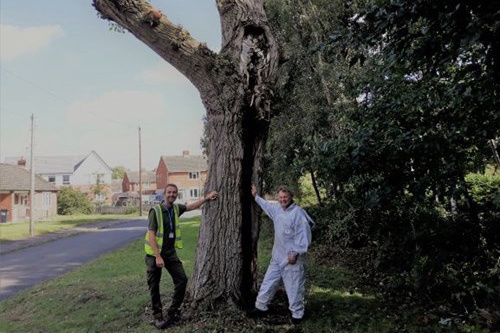
A busy nest of bees was saved from homelessness when some essential tree safety work took place in Wordsley last week.
Qualified officers from the council’s tree inspection team identified a hazardous tree on Marley Road in Wordsley as part of their routine inspection
The team spotted a bees’ nest within the tree and recognised the importance of safeguarding the hive whilst making the tree itself safe.
Working with a specialist contractor and Hagley and Stourbridge Beekeepers’ Association, the tree was sympathetically cut back to make it safe while retaining the part of the tree the bees have colonised, allowing them to keep their home. The remainder of the stem will also provide ecological and habitat value for the future. Councillor Karen Shakespeare, cabinet member for environmental, highways and street services, said:
“Our tree inspection team do a great job of maintaining and growing our tree stock so that it’s not only safe but contributes to local ecology.
”When the team identified the bees' nest, they recognised the importance of allowing it to flourish, while keeping the public safe.
“We’re really grateful to the Hagley and Stourbridge Beekeepers’ Association association for all of their advice which has helped us to manage a diseased tree, while also continuing to provide a safe home for this colony of bees.”
Nick Templar, apiary manager, Hagley and Stourbridge Beekeepers’ Association added:
“It’s been really good to work with the council to maintain this nest. The whole job has been done really sensitively to make sure that the bees can continue to thrive and the tree itself can continue to grow.
”The tree will provide a safe haven for the bees over the winter as the trunk retains both heat and moisture so hopefully we will continue to see lots of happy honey bees in the future”
The team ordinarily deals with the inspection and care of the council's tree stock, primarily on highways and parks and open spaces. While they focus on the removal or pruning of dead, dying or dangerous trees in order to make spaces safe for residents, they also work to promote biodiversity and safeguarding native wildlife.
This includes the retention of dead trees and dead wood within trees in appropriate locations where public safety is not compromised where it has a high wildlife value.














Comments
Add a comment